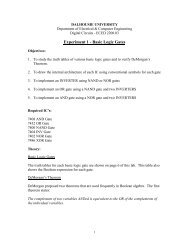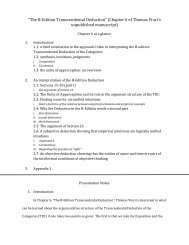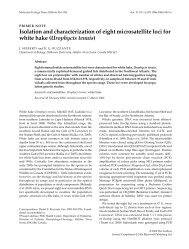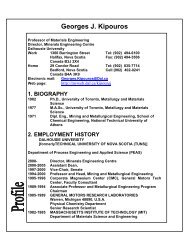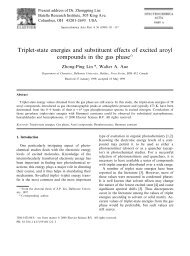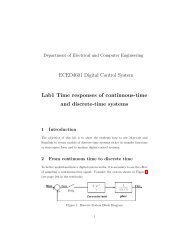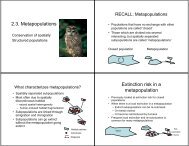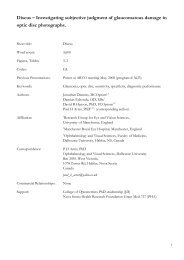Information Gathering: Unobtrusive Methods - Myweb.dal.ca
Information Gathering: Unobtrusive Methods - Myweb.dal.ca
Information Gathering: Unobtrusive Methods - Myweb.dal.ca
You also want an ePaper? Increase the reach of your titles
YUMPU automatically turns print PDFs into web optimized ePapers that Google loves.
<strong>Information</strong> <strong>Gathering</strong>:<br />
<strong>Unobtrusive</strong> <strong>Methods</strong>
Learning Objectives<br />
• Recognize the value of unobtrusive methods for<br />
information gathering.<br />
• Understand the concept of sampling for human<br />
information requirements analysis.<br />
• Construct useful samples of people, documents, and<br />
events for determining human information<br />
requirements.<br />
• Create an analyst’s playscript to observe decisionmaker<br />
activities.<br />
• Apply the STROBE technique to observe and interpret<br />
the decision-maker’s environment and their<br />
interaction with technologies.<br />
Ken<strong>dal</strong>l & Ken<strong>dal</strong> Copyright © 2011 Pearson Edu<strong>ca</strong>tion, Inc. Publishing as Prentice Hall 5-2
<strong>Unobtrusive</strong> <strong>Methods</strong><br />
• Less disruptive<br />
• Insufficient when used alone<br />
• Multiple methods approach<br />
• Used in conjunction with interactive<br />
methods<br />
Ken<strong>dal</strong>l & Ken<strong>dal</strong> Copyright © 2011 Pearson Edu<strong>ca</strong>tion, Inc. Publishing as Prentice Hall 5-3
Major Topics<br />
• Sampling<br />
• Quantitative document analysis<br />
• Qualitative document analysis<br />
• Observation<br />
• STROBE<br />
• Applying STROBE<br />
Ken<strong>dal</strong>l & Ken<strong>dal</strong> Copyright © 2011 Pearson Edu<strong>ca</strong>tion, Inc. Publishing as Prentice Hall 5-4
Sampling<br />
• A process of systemati<strong>ca</strong>lly selecting<br />
representative elements of a population<br />
• Involves two key decisions:<br />
• What to examine<br />
• Which people to consider<br />
Ken<strong>dal</strong>l & Ken<strong>dal</strong> Copyright © 2011 Pearson Edu<strong>ca</strong>tion, Inc. Publishing as Prentice Hall 5-5
Need for Sampling<br />
The reasons systems analysts do<br />
sampling are:<br />
• Containing costs<br />
• Speeding up the data gathering<br />
• Improving effectiveness<br />
• Reducing bias<br />
Ken<strong>dal</strong>l & Ken<strong>dal</strong> Copyright © 2011 Pearson Edu<strong>ca</strong>tion, Inc. Publishing as Prentice Hall 5-6
Sampling Design<br />
• To design a good sample, a systems<br />
analyst must follow four steps:<br />
• Determining the data to be collected or<br />
described<br />
• Determining the population to be sampled<br />
• Choosing the type of sample<br />
• Deciding on the sample size<br />
Ken<strong>dal</strong>l & Ken<strong>dal</strong> Copyright © 2011 Pearson Edu<strong>ca</strong>tion, Inc. Publishing as Prentice Hall 5-7
Four Main Types of Samples the<br />
Analyst Has Available (Figure 5.1)<br />
Ken<strong>dal</strong>l & Ken<strong>dal</strong> Copyright © 2011 Pearson Edu<strong>ca</strong>tion, Inc. Publishing as Prentice Hall 5-8
The Sample Size Decision<br />
• Determine the attribute.<br />
• Lo<strong>ca</strong>te the database or reports in which the<br />
attribute <strong>ca</strong>n be found.<br />
• Examine the attribute.<br />
• Make the subjective decision regarding the<br />
acceptable interval estimate.<br />
• Choose the confidence level.<br />
• Calculate the standard error.<br />
• Determine the sample size.<br />
Ken<strong>dal</strong>l & Ken<strong>dal</strong> Copyright © 2011 Pearson Edu<strong>ca</strong>tion, Inc. Publishing as Prentice Hall 5-9
A Table of Area under a Normal Curve Can Be Used to<br />
Look up a Value Once the Systems Analyst Decides on<br />
the Confidence Level (Figure 5.2)<br />
Ken<strong>dal</strong>l & Ken<strong>dal</strong> Copyright © 2011 Pearson Edu<strong>ca</strong>tion, Inc. Publishing as Prentice Hall 5-10
Calculate the Standard Error of<br />
the Proportion<br />
s p = i/z<br />
i = interval estimate<br />
z = confidence<br />
coefficient found in<br />
the confidence level<br />
lookup table<br />
Ken<strong>dal</strong>l & Ken<strong>dal</strong> Copyright © 2011 Pearson Edu<strong>ca</strong>tion, Inc. Publishing as Prentice Hall 5-11
Determine the Sample Size<br />
p(1-p)<br />
n = + 1<br />
σ p 2<br />
σ p = standard error<br />
ρ = the proportion of the population having<br />
the attribute<br />
Ken<strong>dal</strong>l & Ken<strong>dal</strong> Copyright © 2011 Pearson Edu<strong>ca</strong>tion, Inc. Publishing as Prentice Hall 5-12
Example: A. Sembly Company<br />
• Determine that you are looking for orders with<br />
mistakes .<br />
• Lo<strong>ca</strong>te order forms from the past six months.<br />
• Examine order forms and conclude that p=5%.<br />
• Subjective decision of acceptable interval i = ± 0.02<br />
• Look up confidence coefficient z-value = 1.96.<br />
• Calculate s p = i / z = 0.02/1.96 = 0.0102.<br />
• Determine n; n = 458.<br />
Ken<strong>dal</strong>l & Ken<strong>dal</strong> Copyright © 2011 Pearson Edu<strong>ca</strong>tion, Inc. Publishing as Prentice Hall 5-13
Investigation<br />
• The act of discovery and analysis of<br />
data<br />
• Hard data<br />
• Quantitative<br />
• Qualitative<br />
Ken<strong>dal</strong>l & Ken<strong>dal</strong> Copyright © 2011 Pearson Edu<strong>ca</strong>tion, Inc. Publishing as Prentice Hall 5-14
Analyzing Quantitative Documents<br />
• Reports used for decision making<br />
• Performance reports<br />
• Records<br />
• Data <strong>ca</strong>pture forms<br />
• Ecommerce and other transactions<br />
Ken<strong>dal</strong>l & Ken<strong>dal</strong> Copyright © 2011 Pearson Edu<strong>ca</strong>tion, Inc. Publishing as Prentice Hall 5-15
Reports Used for Decision Making<br />
• Sales reports<br />
• Production reports<br />
• Summary reports<br />
Ken<strong>dal</strong>l & Ken<strong>dal</strong> Copyright © 2011 Pearson Edu<strong>ca</strong>tion, Inc. Publishing as Prentice Hall 5-16
A Performance Report Showing<br />
Improvement (Figure 5.3)<br />
Ken<strong>dal</strong>l & Ken<strong>dal</strong> Copyright © 2011 Pearson Edu<strong>ca</strong>tion, Inc. Publishing as Prentice Hall 5-17
A Manually Completed Payment<br />
Record (Figure 5.4)<br />
Ken<strong>dal</strong>l & Ken<strong>dal</strong> Copyright © 2011 Pearson Edu<strong>ca</strong>tion, Inc. Publishing as Prentice Hall 5-18
Data Capture Forms<br />
• Collect examples of all the forms in use.<br />
• Note the type of form.<br />
• Document the intended distribution<br />
pattern.<br />
• Compare the intended distribution<br />
pattern with who actually receives the<br />
form.<br />
Ken<strong>dal</strong>l & Ken<strong>dal</strong> Copyright © 2011 Pearson Edu<strong>ca</strong>tion, Inc. Publishing as Prentice Hall 5-19
Questions to Ask about Official and Bootleg<br />
Forms that Are Already Filled out (Figure 5.5)<br />
Ken<strong>dal</strong>l & Ken<strong>dal</strong> Copyright © 2011 Pearson Edu<strong>ca</strong>tion, Inc. Publishing as Prentice Hall 5-20
Analyzing Qualitative<br />
Documents<br />
• Key or guiding metaphors<br />
• Insiders vs. outsiders mentality<br />
• What is considered good vs. evil<br />
• Graphics, logos, and icons in common<br />
areas or Web pages<br />
• A sense of humor<br />
Ken<strong>dal</strong>l & Ken<strong>dal</strong> Copyright © 2011 Pearson Edu<strong>ca</strong>tion, Inc. Publishing as Prentice Hall 5-21
Analyzing Qualitative<br />
Documents<br />
• Email messages and memos<br />
• Signs or posters on bulletin boards<br />
• Corporate Web sites<br />
• Manuals<br />
• Policy handbooks<br />
Ken<strong>dal</strong>l & Ken<strong>dal</strong> Copyright © 2011 Pearson Edu<strong>ca</strong>tion, Inc. Publishing as Prentice Hall 5-22
Analysis of Memos Provides Insight into the Metaphors<br />
that Guide the Organization’s Thinking (Figure 5.6)<br />
Ken<strong>dal</strong>l & Ken<strong>dal</strong> Copyright © 2011 Pearson Edu<strong>ca</strong>tion, Inc. Publishing as Prentice Hall 5-23
Observation<br />
• Observation provides insight on what<br />
organizational members actually do.<br />
• See firsthand the relationships that exist<br />
between decision makers and other<br />
organizational members<br />
• Can also reveal important clues<br />
regarding HCI concerns<br />
Ken<strong>dal</strong>l & Ken<strong>dal</strong> Copyright © 2011 Pearson Edu<strong>ca</strong>tion, Inc. Publishing as Prentice Hall 5-24
Analyst’s Playscript<br />
• Involves observing the decision-makers<br />
behavior and recording their actions<br />
using a series of action verbs<br />
• Examples:<br />
• Talking<br />
• Sampling<br />
• Corresponding<br />
• Deciding<br />
Ken<strong>dal</strong>l & Ken<strong>dal</strong> Copyright © 2011 Pearson Edu<strong>ca</strong>tion, Inc. Publishing as Prentice Hall 5-25
A Sample Page from the Analyst’s Playscript<br />
Describing Decision Making (Figure 5.7)<br />
Ken<strong>dal</strong>l & Ken<strong>dal</strong> Copyright © 2011 Pearson Edu<strong>ca</strong>tion, Inc. Publishing as Prentice Hall 5-26
STROBE<br />
STRuctured OBservation of the<br />
Environment—a technique for observing<br />
the decision-maker’s physi<strong>ca</strong>l<br />
environment<br />
Ken<strong>dal</strong>l & Ken<strong>dal</strong> Copyright © 2011 Pearson Edu<strong>ca</strong>tion, Inc. Publishing as Prentice Hall 5-27
STROBE Elements<br />
• Office lo<strong>ca</strong>tion<br />
• Desk placement<br />
• Stationary equipment<br />
• Props<br />
• External information sources<br />
• Office lighting and color<br />
• Clothing worn by decision makers<br />
Ken<strong>dal</strong>l & Ken<strong>dal</strong> Copyright © 2011 Pearson Edu<strong>ca</strong>tion, Inc. Publishing as Prentice Hall 5-28
Office Lo<strong>ca</strong>tion<br />
• Accessible offices<br />
• Main corridors, open door<br />
• Major traffic flow area<br />
• Increase interaction frequency and<br />
informal messages<br />
• Inaccessible offices<br />
• May view the organization differently<br />
• Drift apart from others in objectives<br />
Ken<strong>dal</strong>l & Ken<strong>dal</strong> Copyright © 2011 Pearson Edu<strong>ca</strong>tion, Inc. Publishing as Prentice Hall 5-29
Desk Placement<br />
• Visitors in a tight space, back to wall,<br />
large expanse behind desk<br />
• Indi<strong>ca</strong>tes maximum power position<br />
• Desk facing the wall, chair at side<br />
• Encourages participation<br />
• Equal exchanges<br />
Ken<strong>dal</strong>l & Ken<strong>dal</strong> Copyright © 2011 Pearson Edu<strong>ca</strong>tion, Inc. Publishing as Prentice Hall 5-30
Stationary Office Equipment<br />
File <strong>ca</strong>binets and bookshelves:<br />
• If not present, person stores few<br />
items of information personally<br />
• If an abundance, person stores<br />
and values information<br />
Ken<strong>dal</strong>l & Ken<strong>dal</strong> Copyright © 2011 Pearson Edu<strong>ca</strong>tion, Inc. Publishing as Prentice Hall 5-31
Props<br />
• Calculators<br />
• Personal computers<br />
• Pens, pencils, and rulers<br />
• If present, person processes data<br />
personally<br />
Ken<strong>dal</strong>l & Ken<strong>dal</strong> Copyright © 2011 Pearson Edu<strong>ca</strong>tion, Inc. Publishing as Prentice Hall 5-32
External <strong>Information</strong> Sources<br />
• Trade journals or newspapers indi<strong>ca</strong>te<br />
the person values outside information.<br />
• Company reports, memos, and policy<br />
handbooks indi<strong>ca</strong>te the person values<br />
internal information.<br />
Ken<strong>dal</strong>l & Ken<strong>dal</strong> Copyright © 2011 Pearson Edu<strong>ca</strong>tion, Inc. Publishing as Prentice Hall 5-33
Office Lighting and Color<br />
• Warm, in<strong>ca</strong>ndescent lighting indi<strong>ca</strong>tes:<br />
• A tendency toward more personal<br />
communi<strong>ca</strong>tion<br />
• More informal communi<strong>ca</strong>tion<br />
• Brightly lit, bright colors indi<strong>ca</strong>te:<br />
• More formal communi<strong>ca</strong>tions (memos,<br />
reports)<br />
Ken<strong>dal</strong>l & Ken<strong>dal</strong> Copyright © 2011 Pearson Edu<strong>ca</strong>tion, Inc. Publishing as Prentice Hall 5-34
Clothing<br />
• Male<br />
• Formal two-piece suit—maximum authority<br />
• Casual dressing (sport jacket/slacks)—<br />
more participative decision making<br />
• Female<br />
• Skirted suit—maximum authority<br />
Ken<strong>dal</strong>l & Ken<strong>dal</strong> Copyright © 2011 Pearson Edu<strong>ca</strong>tion, Inc. Publishing as Prentice Hall 5-35
Observe a Decision Maker’s Office for Clues<br />
Concerning His or Her Personal Storage, Processing,<br />
and Sharing of <strong>Information</strong> (Figure 5.9)<br />
Ken<strong>dal</strong>l & Ken<strong>dal</strong> Copyright © 2011 Pearson Edu<strong>ca</strong>tion, Inc. Publishing as Prentice Hall 5-36
Applying STROBE<br />
• The five symbols used to evaluate how<br />
observation of the elements of STROBE<br />
compared with interview results are:<br />
• A checkmark means the narrative is confirmed.<br />
• An “X” means the narrative is reversed.<br />
• An oval or eye-shaped symbol serves as a cue to<br />
look further.<br />
• A square means observation modifies the<br />
narrative.<br />
• A circle means narrative is supplemented by<br />
observation.<br />
Ken<strong>dal</strong>l & Ken<strong>dal</strong> Copyright © 2011 Pearson Edu<strong>ca</strong>tion, Inc. Publishing as Prentice Hall 5-37
An Anecdotal List with Symbols for<br />
Use in Applying STROBE (Figure 5.11)<br />
Ken<strong>dal</strong>l & Ken<strong>dal</strong> Copyright © 2011 Pearson Edu<strong>ca</strong>tion, Inc. Publishing as Prentice Hall 5-38
Summary<br />
• Sampling<br />
• Designing a good sample<br />
• Types of samples<br />
• Sample size<br />
• Hard data<br />
• Quantitative document analysis<br />
• Qualitative document analysis<br />
• Observation<br />
• Playscript<br />
• STROBE<br />
• STROBE elements<br />
• Applying STROBE<br />
Ken<strong>dal</strong>l & Ken<strong>dal</strong> Copyright © 2011 Pearson Edu<strong>ca</strong>tion, Inc. Publishing as Prentice Hall 5-39



